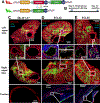Artificial intelligence-guided design of lipid nanoparticles for pulmonary gene therapy
- PMID: 39658727
- PMCID: PMC12149338
- DOI: 10.1038/s41587-024-02490-y
Artificial intelligence-guided design of lipid nanoparticles for pulmonary gene therapy
Abstract
Ionizable lipids are a key component of lipid nanoparticles, the leading nonviral messenger RNA delivery technology. Here, to advance the identification of ionizable lipids beyond current methods, which rely on experimental screening and/or rational design, we introduce lipid optimization using neural networks, a deep-learning strategy for ionizable lipid design. We created a dataset of >9,000 lipid nanoparticle activity measurements and used it to train a directed message-passing neural network for prediction of nucleic acid delivery with diverse lipid structures. Lipid optimization using neural networks predicted RNA delivery in vitro and in vivo and extrapolated to structures divergent from the training set. We evaluated 1.6 million lipids in silico and identified two structures, FO-32 and FO-35, with local mRNA delivery to the mouse muscle and nasal mucosa. FO-32 matched the state of the art for nebulized mRNA delivery to the mouse lung, and both FO-32 and FO-35 efficiently delivered mRNA to ferret lungs. Overall, this work shows the utility of deep learning for improving nanoparticle delivery.
© 2024. The Author(s), under exclusive licence to Springer Nature America, Inc.
Conflict of interest statement
Competing interests: J.W., I.R. and D.G.A. have filed a patent for the 4CR ketone biodegradable lipid library described herein and J.W., R.S.M. and D.G.A. have filed a patent for the branched-ester library described herein. Z.Y. and J.F.E. are consultants for Spirovant Sciences. D.G.A. receives research funding from Sanofi/Translate Bio and is a Founder of oRNA Tx. R.L. is a co-founder and board of director of Moderna. He also serves on the board and has equity in Particles For Humanity. For a list of entities with which R.L. is, or has been recently involved compensated or uncompensated, see https://www.dropbox.com/s/yc3xqb5s8s94v7x/Rev%20Langer%20COI.pdf?dl=0 . The other authors declare no competing interests.
Figures





References
-
- Barbier AJ, Jiang AY, Zhang P, Wooster R & Anderson DG The clinical progress of mRNA vaccines and immunotherapies. Nat. Biotechnol. 40, 840–854 (2022). - PubMed
MeSH terms
Substances
Grants and funding
- P30 ES005605/ES/NIEHS NIH HHS/United States
- P01 HL152960/HL/NHLBI NIH HHS/United States
- n/a/Sanofi
- HL162564-02, R61AI161805/U.S. Department of Health & Human Services | National Institutes of Health (NIH)
- HL162564-02/U.S. Department of Health & Human Services | National Institutes of Health (NIH)
- WITTEN19XX0, 004831F5222/Cystic Fibrosis Foundation (CF Foundation)
- 75N92019C00010/HL/NHLBI NIH HHS/United States
- N/a/Sanofi
- R01 HL162564/HL/NHLBI NIH HHS/United States
- P30 CA014051/CA/NCI NIH HHS/United States
- 5P30-CA14051/U.S. Department of Health & Human Services | NIH | National Cancer Institute (NCI)
- P30 DK054759/DK/NIDDK NIH HHS/United States
- R33 AI161805/AI/NIAID NIH HHS/United States
- R61 AI161805/AI/NIAID NIH HHS/United States
- HL152960, DK054759, 75N92019C00010/U.S. Department of Health & Human Services | National Institutes of Health (NIH)
LinkOut - more resources
Full Text Sources
Medical

